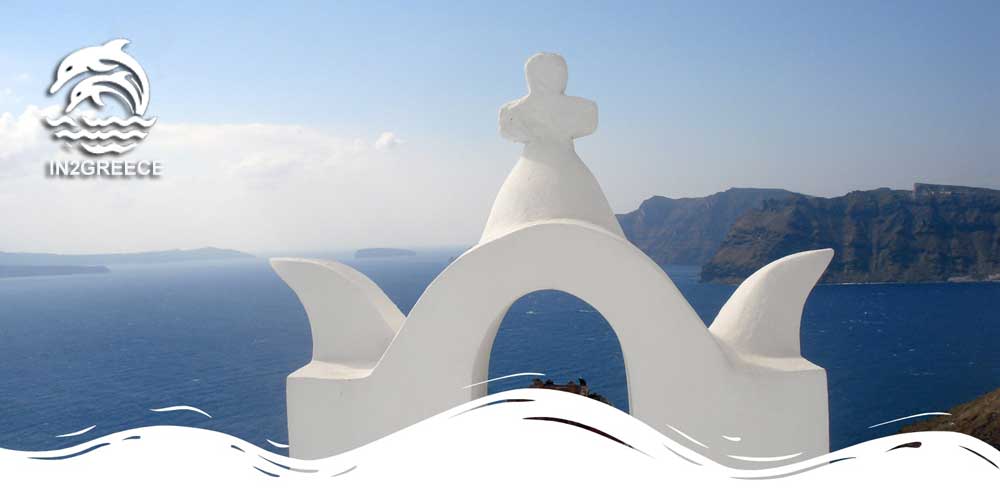Icaria island Greece
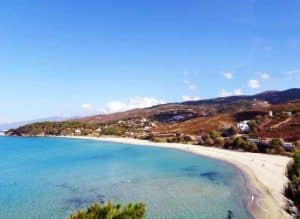
Icaria, also spelt Ikaria, lies is the most southern of the North Aegean islands just off the Turkish coast about 20 kilometres south-west of the major island of Samos.
Since ancient times, Icaria has been famous for it’s dark red wine, its thermal springs and for the legend of Icarus who flew too close to the sun, melting his wings of feathers and wax.
Icaria is a large island and unfairly neglected by holiday firms. It’s not immediately appealing with a long mountain mass and steep mountain cliffs that plunge into the sea along a coastline that has few sheltered bays or good harbours.
But Icaria has its strong adherents amongst tourists that do visit and, although few in number, the best of the Icaria beaches can compare with any to be found in the Greek islands.
The larger villages are confined to Icaria’s coastal plains as the interior is rocky and rugged and its small mountain villages are remote and unkempt.
The best beaches are on the north coast and vary from long swathes of fine sand to sheltered coves of pebble and stone.
Icaria is an island for those seeking a Greek holiday off the beaten track with a the taste of authentic old world Greece, away from the crowds.
Accommodation on Icaria ranges from self contained villas to all-inclusive holiday hotels. Expect decent meals too in the many quality traditional tavernas to be found on the island.
Icaria is probably one of the most beautiful islands in Greece. It is very mountainous and and at some points quite inaccessible, with lovely, green valleys, wild falcons and some amazing beaches.
Although Icaria is not a very touristy island, you can get basically everything here: water sports, nightlife, shops and car rentals. The people on the island live off fishing and farming, and many work on boats or are involved in tourism. The Icarian wine has been produced and praised since antiquity.
The island is often called the red island since the majority of its people belong to the left. The island was used as a place of exile for the communists after the end of the Second World War and this explains the political position of the people of Icaria.
In the island was exiled the famous Greek writer Menelaos Lountemis . The isolation and poverty have forced many of Icaria’s inhabitants to immigrate, mainly in the US of America.
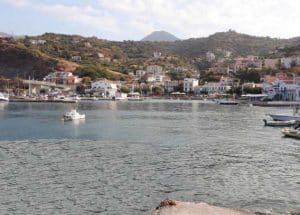
Its residents will tell you to relax and mean it, as the pace here is slow and the smartest move is to adapt to it. At 255 sq. km. of its area unfolds particularly natural landscapes protected by the Natura 2000 program and will be appreciated by those looking for low-key nature-loving and sightseeing holidays.
Dare to introduce yourself to the lush vegetation, pine forests, gorges, rivers and streams following the various hiking trails. Take your equipment for all kinds of water sports and your mask for diving in the deep crystal waters of the Icarian Sea and indulge in endless searching of lacy shores with sand or pebbles.
The quiet Agios Kyrykos, capital of the island, and the more funky Evdilos in the North (both ports of Icaria) will cover your every need for accommodation, food and entertainment and will be a starting point for excursions in the countryside.
Walk through the alleys of the picturesque settlements, admire the architectural styles of the buildings with the tiled roofs and the stone mansions with the aristocratic refinement and also benefit from the healing properties of the hot springs that you will discover in many parts of the island.
The famous festivals deserve a special mention, which teach travelers what it means to be Icarian and a feast made in Greece! Nowhere in Greece will you find so many: there are about fifty, almost as many as the villages of the island.
Mythology
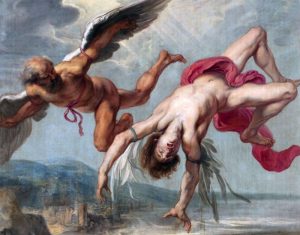
To escape, Daedalus crafted two sets of wings made of feathers and wax. He warned Icarus not to fly too close to the sun, but Icarus, enthralled by the thrill of flight, ignored the warning. The wax in his wings melted from the sun’s heat, causing him to fall from the sky and into the sea near Icaria, which was then named in his memory.
Icaria is also intricately linked with Dionysus, the god of wine, festivity, and ecstasy in Greek mythology. Legend has it that Dionysus found a safe haven on Icaria, where he was welcomed and celebrated by the islanders. In return, Dionysus blessed the island with fertile vineyards and taught the locals the art of winemaking. This mythological association lives on in Icaria’s robust winemaking tradition, with the island known for producing some of the finest wines in the Aegean
History
References to Icaria can be found from Antiquity but also later in the Roman, Byzantine and Turkish periods.For many people Icaria is known as a place of exile. During the period of the dictatorship of Metaxas in the 30’s, several of his political opponents were exiled there, just as after the Second World War and the Civil War, they sent to exile in Icaria the Democratic Greeks
But also during the Byzantine times, there they exiled persons of the royal family and other notables particularly dangerous for the throne. The exiles of this period develop close relationships with the inhabitants of the island, even family ties, and settle there permanently. In the years that followed, the Icarians had acquired an arrogance because they considered themselves Porphyroborn and for this reason they also forbade intermarriage with xenomerites, “in order to keep the imperial blood that flowed in their veins uncontaminated”.
During the period of piracy (1500-1700) Icaria gives the impression of desolation. Full of dense forests from its mountain peaks to the coasts, with inaccessible cliffs and underground caves covered by centuries-old bushes, it became the natural protection of the island’s inhabitants, who lived inside these cavities that they called arches, ensuring their survival from the pirates who roamed the Aegean.
Geography
Icaria has a rich geological and mineralogical structure. The western part of the island consists almost exclusively of gneissiogranite (Fradato, Rahes, Karkinagri) while the eastern part of the gneiss system (Plagia – Apericho). Quantitatively, diamamarigian gneiss, rich in muscovite, predominates. There are also slates in the areas of Messaria and the southern coastal zone from Agios Kyrykos to Kerame.
Marble and limestones are found in the areas of Ikari, Pountas, Agios Kirikos and Fanarios as well as granites in the area of Xylosyrtiou-Glaredos. It is considered that these rocks are Pre-Devonian in age and that the island belongs to the core of the Lydikocarian ice mass. On the island in general and in particular in the area of Agios Kirikos, iron ore deposits have been identified, which were previously under exploitation
Icaria has no lowlands except for Kambos and Faros. However, due to its strong natural relief, it has valleys, ravines and small plateaus as well as basins at a higher altitude, many of which are not visible from the sea. These areas are Perdiki, Stavlos, Kampa, Plakoti, Pezi, etc. The coastline shows little horizontal fragmentation with minimal indentations. Noteworthy are the open bay of Agriomelissa and the bay of Agios Nikolaos to the south with Cape Papas. The first port of the island was built in 1972
Flora and Fauna
Icaria’s rich flora and fauna make it a microcosm of the Mediterranean’s natural beauty and biodiversity. The island’s commitment to preserving its unique environment serves as a model for conservation efforts worldwide. For nature enthusiasts and eco-tourists, Ikaria offers a rare glimpse into an unspoiled natural world, where the harmonious coexistence of humans and nature continues to thrive.
Despite its natural beauty and ecological significance, Icaria faces challenges such as habitat loss, pollution, and the impacts of climate change. Overgrazing, deforestation, and unsustainable fishing practices threaten the delicate balance of its ecosystems.
In response to these challenges, local and international conservation groups are working to protect Ikaria’s natural heritage. Efforts include habitat restoration, sustainable tourism initiatives, and environmental education programs aimed at fostering a deeper appreciation and understanding of the island’s natural treasures among both locals and visitors.
Climate
The climate in Icaria is mild Mediterranean type. As a rule, there is a lot of rain in the winter season. The frequent presence of fog and cloud formations on the peaks cause increased humidity in the air even in summer. The advantage of the strong wind is the southern part where the coastal zone has no waves at all. Conversely when the weather is southerly then the northern part has strong winds and coastal calm while the southern part has beastly waves and no wind at all. Meltemias are an important weather phenomenon of the summer season with great intensity from mid-July to mid-September.
What to see in Icaria
Temple of Artemis the Tauropole
On the northwestern side of Icaria, in the area of Na, was established the famous ancient temple of Artemis the Tauropole. It was built in the 6th century BC. and was one of the most important places of worship on the island.
They say that there used to be an ancient settlement in Na, where the so-called Naiads lived. The prevailing opinion is that the name of the area is due to the temple that was built there. Inside the sanctuary was the large statue of the goddess Artemis which has not been preserved.
The temple was destroyed in the 18th-19th century and its materials were used to build churches. Only the floor and foundations remain of that remarkable sanctuary. Next to the temple, on the bank of the river Halaris, there are also remains of the waterfront of the old port that was built by the inhabitants during the 14th-15th century.
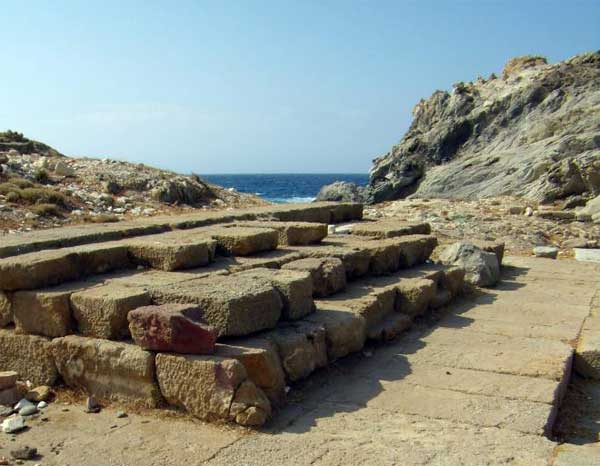
Oinoi
In the area of Kampos was the ancient capital of the island, which you will also hear called Dionysia. Today only the remains of the wall and the ruined building of the Byzantine period remain to remind something of its past glory.
Drakano
If you are fans of the Alexandrian years, take the road to the east of the island. The so-called homeland of Dionysus once stood in the Fanari area. Here are preserved ruins of the ancient castle and on a hill is the tower, which dates from the 4th BC. century.
Castle of Koskinas
Just outside the village of Kosoikia, in the north of the island, admire this Byzantine fortress – the church of Ai-Georgis Dorganas is also built inside it. It was built by Byzantines on top of a conical hill in the 10th century. and, due to good visibility, it was intended for the installation of a small military unit that observed from its privileged position the entire area and the sea lanes. The Castle was strengthened when Icaria came under the possession of the Genoese (1362-1481), but was deserted when the Genoese left the island and retired to Chios.
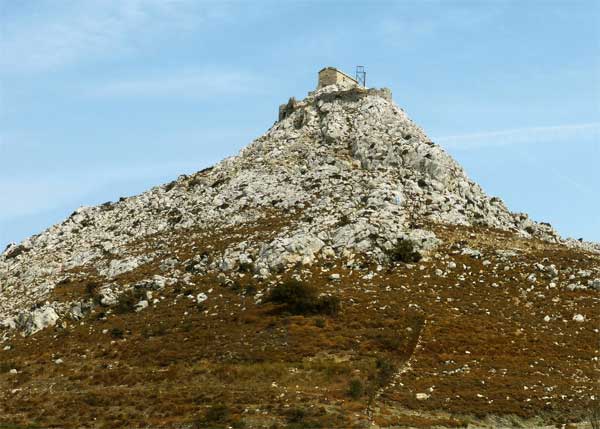
Gladero
Also look for the village of Glaredo, where a Neolithic settlement has been identified, the megalithic monuments north of Drakanos and the ruins of the Roman conservatory on the north side of the hill of Agia Irini.
Museums
Visit the Folklore-Historical Museum of Agios Kirikos and the Kampos Museum, where you will see pottery, stone and bronze tools, amphorae, clay figurines, relief tombstones, coins and many other exhibits. You will get to know local traditions and customs at the folklore museums of Agios Polykarpos and Vrakade.
Local festivals
If you want to see what Icaria means, you must definitely find yourself at a festival and become one with the dancing crowd, drink plenty of wine and accompany it with boiled or grilled meat.
The opening festival is t’ ai Si’eru (Saint Isidore) in Pezi on May 14th and the last one of Saint Sophia in Monocampi on September 17th, the best ones, however, are held on the Fifteenth of August and last from the morning of a day until the next morning.
Where to swimm
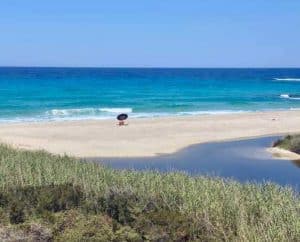
Locals claim that Iero is the most beautiful beach: in this windless cove with turquoise waters you will find refuge on days when the winds are strong and the waves are threatening.
In the south of the island, Anefadi is ideal for those of you who love fishing, since the caves and rocks at the bottom are perfect for spearfishing. In Armenistis you will find the much-desired tranquility you are looking for. In Gialiskari, next to Mesakti, is Livadi, one of the busiest beaches of the island.
Specifically in August you will struggle to find a place to put even your bag. Surfers will love Mesakti, as the winds are ideal and access is easy, so you won’t need to carry your gear on your back.
A special beach is also the one in Na, which stretches out at the mouth of a river. Go down the steps to reach it and dive into the emerald waters. Here you will also see the temple of Tauropoulos Artemis, also ask about the path that leads to the lake and dare to take a dip in the waters below the Chalaris waterfall.
With beautiful postcard-perfect turquoise waters, reaching the Seychelles will require a bit of a walk at the end, but what you’ll see once you arrive will make up for it.
Finally, Fanari is the longest beach of the island and the tamarisk trees along it generously provide their shade. This is the ideal place for you who love diving and exploring the seabed.
Day trips from Icaria
Fourni, the three islands between Icaria and Samos, are a must for a day trip. The boat from the port of Agios Kirikos will take you in dt time to Fournos, where you will find hospitable people and absolute tranquility.
You can even stay there, as there is plenty of accommodation and the few tavernas have fresh seafood on their menu, and the beaches are beautiful too – in some places they are steep and in others they form small coves.
The best known being Bali, Kamari, Kambi and Agios Ioannis. Another alternative for an excursion is the island of Thymaina with a genuine fishing village and the beautiful coast of Kerameido.
Towns and Villages of Icaria
Agios Kirikos
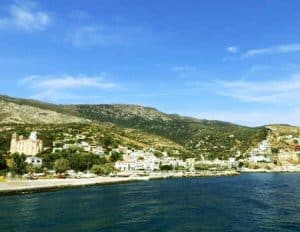
Many buildings are relatively new and have a drab, utilitarian air. Most visitors are here only to book ferries or to catch the island bus.
To the east of the ferry quay is a small strip of pebble used more for beaching fishing boats than for sunbathing. In summer water taxis shuttle visitors to the hot springs at nearby Therma.
A small archaeological museum has free entry and houses many local finds including a well-preserved 500 BC gravestone.
About a kilometre west, just past a couple of nightclubs, is Tsoulka beach, popular with the local youngsters. The tree-fringed pebble beach is just off the main road and has a beach cantina.
A little further west is a long, narrow strip of rock and pebble at Xilosirtis, with a small jetty and a summer cantina. Access is down a stairway path at the lower end of the village.
About a kilometre east, on the coast road to Therma, is a secluded sand and pebble cove at Prioni with access down a very steep path.
Boats in Agios Kirykos port offer excursion trips to the island of Fourni which has beaches, tavernas and good walking trails.
Evdilos
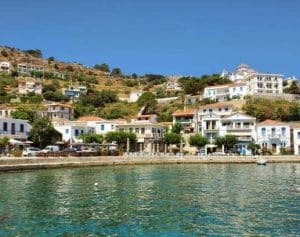
The road climbs steeply over the scrub covered mountain ridge to the more attractive terraced slopes of the north coast.
It’s one of the more traditional settlements on Icaria with cafes on the harbour, stone houses, narrow streets and old mansions.
Evdilos is also home to the Hellenic Cultural Centre which runs courses for foreigners covering all things Greek, from language, literature and culture to cookery and dancing.
A small, quiet sand and stone beach is seldom visited except by the locals as it has no facilities. Better beaches are within walking distance both east and west.
The west, in particular, has a series of good sandy strips but visitors are warned of dangerous currents along this stretch of coast and care must be taken when swimming.
Akamatra
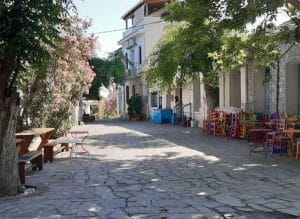
The central square has a 500 year-old oak tree, once used as a gallows. There are also several mansion houses in the village with fine balconies.
Just to the south-east lies the area of Alama, where a stoned paved path leads through a dense woodland of towering plane trees, ancient water mills and past springs that supply water to the village.
At one spring is the Alama cave, full of stalactites and stalagmites, and at nearby Arethousa is the much photographed Theokepasti chapel which has been carved out of the rock.
Armenistis
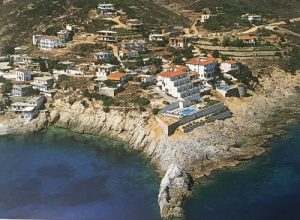
The village consists of clusters of newly restored old houses that climb up the hillside overlooking the fishing boats in the harbour and a small patch of beach about 13 kilometres west of Evdilos.
The traditional old Greek village only has about 70 permanent residents but a n number of small hotels have been built recently. The village has a bakery, mini-market, tavernas and bars. There is also a small museum of Icarian art.
Armenistis is surrounded by dense pine woods fed by abundant fresh water streams and this is the starting point for a number of good island walks.
Messaria
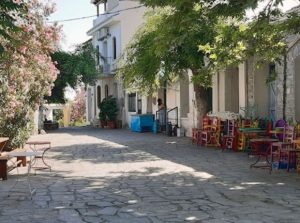
Next to the Castle is a small chapel, Agios – Georgios. In the area of Mesaria, residents from all over the island “immigrated” during the years of piracy, where the residents had abandoned the coasts of the island, but also the areas that were visible from the sea, in order to save themselves from the enemy, building improvised houses or living in arches and moving around, mostly during the night to be invisible from the sea.
Arethousa
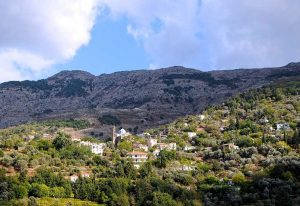
Like many villages on Icaria, Arethousa embodies the laid-back and traditional Greek island lifestyle. You can expect friendly locals, charming architecture, and a relaxed atmosphere, like many Greek villages, celebrates traditional festivals and religious events throughout the year. These festivals often involve music, dance, and delicious food
How to get to Icaria
The island is on the main ferry route between the mainland port of Piraeus and the North Eastern Aegean Island of Samos, which hugs the coast of Turkey and is a three-hour boat ride from Ikaria. Boats stop at both of Icaria’s ports – Evdilos on the north coast and Agios Kirykos on the south coast. If you’re on an island-hopping tour you’ll find it easier to combine a stop at Ikaria with a visit to some of the nearby Cyclades Islands rather than trying to “do” the North Eastern Aegean Islands which are spread far and wide. The Cycladic island of Mykonos, for example, is just two and a half hours by ferry to the west of Icaria whereas Chios (the nearest North Eastern Aegean island to the north) is a gruelling eight and a half hour boat ride away.
There are regular fery services with ferries from Piraeus to Ayios Kirykos, Evdilos and Phourni. Distances Piraeus-Ayios Kirykos 143 nautical miles, Piraeus- Evdilos 136 nautical miles.
Information: Ayios Kirykos port authority, telephone +30227522.207,
Evdilos Port Authority, telephone +30227531.007.
Ayios Kirykos, Evdilos and Fourni are also connected with Vathy and Karlovasi on Samos, and with Paros, Naxos, Syros, Tinos and Mykonos (seasonal service).
